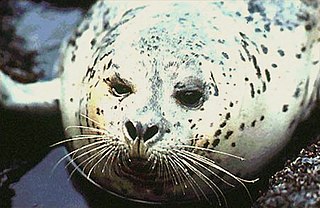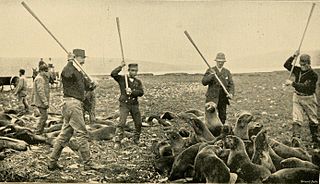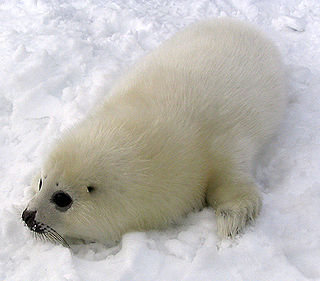
The walrus is a large pinniped marine mammal with discontinuous distribution about the North Pole in the Arctic Ocean and subarctic seas of the Northern Hemisphere. It is the only extant species in the family Odobenidae and genus Odobenus. This species is subdivided into two subspecies: the Atlantic walrus, which lives in the Atlantic Ocean, and the Pacific walrus, which lives in the Pacific Ocean.

Pinnipeds, commonly known as seals, are a widely distributed and diverse clade of carnivorous, fin-footed, semi-aquatic, mostly marine mammals. They comprise the extant families Odobenidae, Otariidae, and Phocidae, with 34 extant species and more than 50 extinct species described from fossils. While seals were historically thought to have descended from two ancestral lines, molecular evidence supports them as a monophyletic lineage. Pinnipeds belong to the suborder Caniformia of the order Carnivora; their closest living relatives are musteloids, having diverged about 50 million years ago.

The ringed seal is an earless seal inhabiting the Arctic and sub-Arctic regions. The ringed seal is a relatively small seal, rarely greater than 1.5 m in length, with a distinctive patterning of dark spots surrounded by light gray rings, hence its common name. It is the most abundant and wide-ranging ice seal in the Northern Hemisphere, ranging throughout the Arctic Ocean, into the Bering Sea and Okhotsk Sea as far south as the northern coast of Japan in the Pacific and throughout the North Atlantic coasts of Greenland and Scandinavia as far south as Newfoundland, and including two freshwater subspecies in northern Europe. Ringed seals are one of the primary prey of polar bears and killer whales, and have long been a component of the diet of indigenous people of the Arctic.

The bearded seal, also called the square flipper seal, is a medium-sized pinniped that is found in and near to the Arctic Ocean. It gets its generic name from two Greek words that refer to its heavy jaw. The other part of its Linnaean name means bearded and refers to its most characteristic feature, the conspicuous and very abundant whiskers. When dry, these whiskers curl very elegantly, giving the bearded seal a "raffish" look.

The grey seal is a large seal of the family Phocidae, which are commonly referred to as "true seals" or "earless seals". The only species classified in the genus Halichoerus, it is found on both shores of the North Atlantic Ocean. In Latin, Halichoerus grypus means "hook-nosed sea pig". Its name is spelled gray seal in the US; it is also known as Atlantic seal and the horsehead seal.

The leopard seal, also referred to as the sea leopard, is the second largest species of seal in the Antarctic. Its only natural predator is the orca. It feeds on a wide range of prey including cephalopods, other pinnipeds, krill, fish, and birds, particularly penguins. It is the only species in the genus Hydrurga. Its closest relatives are the Ross seal, the crabeater seal and the Weddell seal, which together are known as the tribe of Lobodontini seals. The name hydrurga means "water worker" and leptonyx is the Greek for "thin-clawed".

The northern elephant seal is one of two species of elephant seal. It is a member of the family Phocidae. Elephant seals derive their name from their great size and from the male's large proboscis, which is used in making extraordinarily loud roaring noises, especially during the mating competition. Sexual dimorphism in size is great. Correspondingly, the mating system is highly polygynous; a successful male is able to impregnate up to 50 females in one season.

The hooded seal is a large phocid found only in the central and western North Atlantic, ranging from Svalbard in the east to the Gulf of St. Lawrence in the west. The seals are typically silver-grey or white in color, with black spots that vary in size covering most of the body. Hooded seal pups are known as "blue-backs" because their coats are blue-grey on the back with whitish bellies. This coat is shed after 14 months of age when the pups molt. It is the only species in the genus Cystophora.

The Hawaiian monk seal is an endangered species of earless seal in the family Phocidae that is endemic to the Hawaiian Islands.

Phoca is a genus of the earless seals, within the family Phocidae. It now contains just two species, the common seal and the spotted seal. Several species formerly listed under this genus have been split into the genera Pusa, Pagophilus, and Histriophoca. Until recently, Phoca largha has been considered a subspecies of Phoca vitulina but now is considered its own species. For this reason, the fossil history of the genus is unclear, and it has formerly been used as wastebasket taxon for a number of fossils of uncertain affinity.

Seal hunting, or sealing, is the personal or commercial hunting of seals. Seal hunting is currently practiced in nine countries: United States, Canada, Namibia, Denmark, Iceland, Norway, Russia, Finland and Sweden. Most of the world's seal hunting takes place in Canada and Greenland.

The ribbon seal is a medium-sized pinniped from the true seal family (Phocidae). A seasonally ice-bound species, it is found in the Arctic and Subarctic regions of the North Pacific Ocean, notably in the Bering Sea and Sea of Okhotsk. It is distinguished by its striking coloration, with two wide white strips and two white circles against dark brown or black fur.

The spotted seal, also known as the larga seal or largha seal, is a member of the family Phocidae, and is considered a "true seal". It inhabits ice floes and waters of the north Pacific Ocean and adjacent seas. It is primarily found along the continental shelf of the Beaufort, Chukchi, Bering and Okhotsk Seas and south to the northern Yellow Sea and it migrates south as far as northern Huanghai and the western Sea of Japan. It is also found in Alaska from the southeastern Bristol Bay to Demarcation Point during the ice-free seasons of summer and autumn when spotted seals mate and have pups. Smaller numbers are found in the Beaufort Sea. It is sometimes mistaken for the harbor seal to which it is closely related and spotted seals and harbor seals often mingle together in areas where their habitats overlap.

A whitecoat is a newborn harp or grey seal with soft, white fur.
Although the bulk of its area is covered by ice caps inhospitable to most forms of life, Greenland's terrain and waters support a wide variety of plant and animal species. The northeastern part of the island is the world's largest national park. The flora and fauna of Greenland are strongly susceptible to changes associated with climate change.

Hauling-out is a behaviour associated with pinnipeds temporarily leaving the water. Hauling-out typically occurs between periods of foraging activity. Rather than remain in the water, pinnipeds haul-out onto land or sea-ice for reasons such as reproduction and rest. Hauling-out is necessary in seals for mating and giving birth. Other benefits of hauling-out may include predator avoidance, thermoregulation, social activity, parasite reduction and rest.

Pagophily or pagophilia is the preference or dependence on water ice for some or all activities and functions. The term Pagophila is derived from the Ancient Greek pagos meaning "sea-ice", and philos meaning "-loving".

The harborseal, also known as the common seal, is a true seal found along temperate and Arctic marine coastlines of the Northern Hemisphere. The most widely distributed species of pinniped, they are found in coastal waters of the northern Atlantic and Pacific oceans, Baltic and North seas.

The Arctic ringed seal is a subspecies of ringed seals. Arctic ringed seals inhabit the Arctic Ocean, and are the most abundant and wide-ranging seal in the Northern Hemisphere. The ringed seal species is the smallest true seal, and gets its name from a distinctive patterning of light spots on dark grey colored fur. The ringed seal is commonly preyed upon by Polar bears, Arctic foxes, and Killer whales. Population estimates and survival rates are unknown, but average life expectancy is 15-28 years. Ringed seals have long been a component of the diet of indigenous people of the Arctic. Arctic ringed seals have been listed as threatened on the Endangered Species Act since 2012, and increasingly face loss of their habitat due to shrinking ice and snow cover.




























